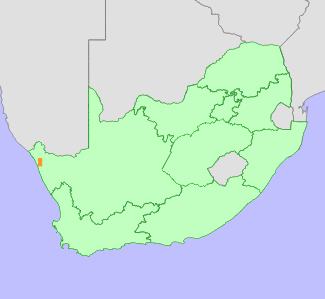|
Scientific Name | Conophytum jucundum (N.E.Br.) N.E.Br. subsp. marlothii (N.E.Br.) S.A.Hammer |
Higher Classification | Dicotyledons |
Family | AIZOACEAE |
Synonyms | Conophytum fraternum (N.E.Br.) N.E.Br. var. leptanthum (L.Bolus) L.Bolus, Conophytum gratum (N.E.Br.) N.E.Br. (in part), Conophytum gratum (N.E.Br.) N.E.Br. subsp. marlothii (N.E.Br.) S.A.Hammer, Conophytum leptanthum L.Bolus, Conophytum marlothii N.E.Br. |
National Status |
Status and Criteria | Critically Endangered A4cd |
Assessment Date | 2021/11/25 |
Assessor(s) | A.J. Young, P.G. Desmet, I. Ebrahim, D. Guo, A. Harrower, L. Jabar, L. Knoetze, C. Rodgerson, P.C.V. Van Wyk & N.N. Mhlongo |
Justification | This succulent is endemic to the Northern Cape of South Africa with an extent of occurrence (EOO) of 32 km² and area of occupancy (AOO) of 28 km², it is only known from two locations. The small population is in decline due to illegal collection to supply the international trade in ornamental succulents, with collection likely to increase as there has been a dramatic increase in the number of species and volume of plants targeted since 2019. Given its restricted geographic range and relatively small population size (estimated at 5,000-10,000 mature individuals) the continued threat of illegal collection is regarded as very high and a complete decline of up to 100% of the population is likely within the next thirty years (one generation). Climate change is also impacting the population although there is uncertainty of the response given the expected resilience of this taxon. It therefore qualifies as Critically Endangered under criterion A4. |
Distribution |
Endemism | South African endemic |
Provincial distribution | Northern Cape |
Range | This succulent is endemic to a small part of the Northern Cape province of South Africa where it is only found in two locations with a severely restricted geographic range. |
Habitat and Ecology |
Major system | Terrestrial |
Major habitats | Vyftienmyl se Berge Succulent Shrubland, Lekkersing Succulent Shrubland |
Description | This succulent is endemic to very small areas of the Richtersveld bioregion in the Succulent Karoo biome. The plants experience winter rainfall and frequent exposure to fog. The plants inhabit quartz terraces amongst gravel, and small vertical cliff faces where they are often found in cracks and crevices. This taxon has a generation length of 30 years. It is expected to be sensitive to the impacts of climate change as it does not disperse and while adapted to arid conditions, is dependent on limited seasonal rainfall. Species in the genus are sensitive to long periods of drought. Drought related mortality has been observed for other closely related taxa within the genus. |
Threats |
| This succulent is currently threatened by illegal collection for the international trade in ornamental succulents. The small population of plants are range-restricted which renders them highly susceptible to a rapid decline in number through collection or other adverse events. The major subpopulation occurs at a locality well known for its succulent diversity and richness and has been regularly targeted by poachers in recent years. Anthropogenic climate change is a long-term threat to this succulent. Loss of vegetation cover has been observed across the geographic range occupied by this taxon via Landsat imagery between 1984 and 2018 indicating a decline in habitat quality. While it is not possible to model the response of this taxon to climate change due to its restricted distribution, the average loss to climate change for 21 more widely distributed Conophytum species occurring within the same region is used as an indication of likely impact to this succulent. Climate models for the likely emission scenarios where emissions stay at present day levels (RCP 2.6) (Hausfather and Peters 2020) and worst case scenarios where emissions continue to increase during the 21st century (RCP 8.5) indicate that there will be a loss of suitable bioclimatic envelope of between 56% and 86% by 2080 for Conophytum taxa within the region. However, as this taxon typically occurs in a sheltered habitat and possesses certain traits likely to afford resilience to xerophytic conditions it is expected to have a level of resilience to climate change and the expected population loss is reduced by 20% to 36%. Species in this genus have limited dispersal ability and migration to suitable habitats elsewhere is regarded as highly unlikely. |
Population |
There are two subpopulations where it is locally common or abundant. The population size is likely to be between 5,000 and 10,000 mature individuals. The population is in decline due to illegal collection to supply the international trade in ornamental succulents. Several hundred plants have been removed from habitat between 2019 and the end of 2021 based on confiscation records, with many more having likely been removed but not intercepted by law enforcers. The population is also suspected to be declining in response to an extended drought in the Richtersveld that started in 2016 and is still ongoing at the time of assessment.
|
Population trend | Decreasing |
Assessment History |
Taxon assessed |
Status and Criteria |
Citation/Red List version | | Conophytum jucundum (N.E.Br.) N.E.Br. subsp. marlothii (N.E.Br.) S.A.Hammer | Rare | 2015.1 | | Conophytum jucundum (N.E.Br.) N.E.Br. subsp. marlothii (N.E.Br.) S.A.Hammer | Least Concern | Raimondo et al. (2009) | |
Bibliography |
Hammer, S. 2002. Dumpling and his wife: New view of the genus Conophytum. EAE Creative Colour, Norwich.
Hammer, S.A. 1993. The genus Conophytum: A conograph. Succulent Plant Publications, Pretoria.
Hausfather, Z. and Peters, G.P. 2020. Emissions - the 'business as usual' story is misleading. Nature 577(618-620).
Opel, M.R. 2004. The rediscovery of Crassula alcicornis. Haseltonia 10:38-40.
|
Citation |
| Young, A.J., Desmet, P.G., Ebrahim, I., Guo, D., Harrower, A., Jabar, L., Knoetze, L., Rodgerson, C., Van Wyk, P.C.V. & Mhlongo, N.N. 2021. Conophytum jucundum (N.E.Br.) N.E.Br. subsp. marlothii (N.E.Br.) S.A.Hammer. National Assessment: Red List of South African Plants version 2024.1. Accessed on 2025/11/07 |
 Comment on this assessment
Comment on this assessment


